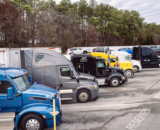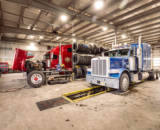/// Guest post by contributor Jon Scharingson, Renewable Energy Group
To blend or not to blend? That is the question many fuel retailers, including travel center operators, ask themselves when they make the decision to add biodiesel to their fuel offerings.
There’s no one-size-fits-all answer. Each location needs to weigh its individual circumstances. But there is information that can help you make that decision.
Let’s take these one at a time.
Purchase Blended Fuel
First, you’ll need to see if your current diesel supplier has a biodiesel blended option or can make one available. If not, find a fuel distributor that does.
You’ll also need to decide what blend level to purchase. These decisions are often made based on weather — travel centers tend to offer lower biodiesel blends in cold weather, although retailers and fleets are successfully using up to a B20 blend year-round throughout North America — and economics. In Texas, for example, retailers currently can save up to 4 cents per gallon on the state fuel tax, depending on the blend level. In Iowa, outlets that sell B5 blends currently get a 4.5-cents-per-gallon tax credit, plus an additional 3-cents-per-gallon tax rollback on B11 and higher blends. Therefore, it makes great economic sense for an Iowa retailer to offer at least a B11 blend. These retailer incentives apply whether you get your fuel blended or blend it yourself.
Blend Yourself
This often provides the best margin opportunities because you can take advantage of positive blending economics, such as when biodiesel is available at a lower price than ULSD.
Blending yourself will require a dedicated biodiesel storage tank that is connected to your diesel tank, and you’ll have to install a blending system. Many travel centers also put in telemetry equipment that allows them to adjust blend levels quickly. For instance, if the blending economics are positive, they will go from a B10 to a B20 blend. These upgrades require a capital investment, but many fuel retailers see a quick payback between six and 18 months. Also, a number of states offer grants and loans to help retailers finance infrastructure upgrades related to biodiesel.
If you purchase biodiesel from a producer, you will need to decide if you want the biodiesel with or without Renewable Identification Numbers (RINs). Every gallon of biodiesel produced generates 1.5 RINs. These can be traded for a monetary value. If you buy the biodiesel without RINs, the RIN value should be captured in the price of the biodiesel. If you buy it with RINs, you can trade them by using a third-party vendor that will likely charge a commission, or you can trade them yourself. At REG, we sell biodiesel with and without RINs, and we offer RINs management.
No matter whether you blend yourself or buy a blended product, it’s important to get your fuel from a dependable supplier. In my last NATSO blog, I offered tips for finding a supplier. You can read that here. As a quick reminder, make sure that your supplier offers high-quality fuel, is knowledgeable about the travel center industry, and has a reliable and cost-effective supply chain to your locations.
Want to learn more? I’d welcome the opportunity to help you find the best fit for biodiesel at your locations. Feel free to contact me at (515) 239-8042 or jon.scharingson@regi.com.
Also, with our help the NATSO Foundation is taking truckstop operators and guests to Chicago July 19, 2017 to learn how to add biodiesel to their truckstop as part of NATSO's Food and Fuel Study Tour. Learn more and register here.
/// Read more guest posts on biodiesel posts here.
{Guest Post} Guest post provided by NATSO Chairman's Circle member Jon Scharingson, Renewable Energy Group. REG is a leading North American advanced biofuels producer and developer of renewable chemicals. REG utilizes a nationwide production, distribution and logistics system as part of an integrated value chain model to focus on converting natural fats, oils and greases into advanced biofuels and converting diverse feedstocks into renewable chemicals. Learn more about Renewable Energy Group.
The opinions and advice given by guest post contributors are not necessarily those of NATSO Inc. The posts should not be considered legal advice. Qualified professionals should be sought regarding advice and questions specific to your circumstances.
Subscribe to Updates
NATSO provides a breadth of information created to strengthen travel plazas’ ability to meet the needs of the travelling public in an age of disruption. This includes knowledge filled blog posts, articles and publications. If you would like to receive a digest of blog post and articles directly in your inbox, please provide your name, email and the frequency of the updates you want to receive the email digest.


